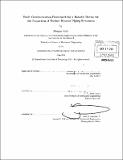Basic communication framework for a robotic device for the inspection of nuclear reactor piping structures
Author(s)
Roth, Meagan (Meagan Ashley)
DownloadFull printable version (6.250Mb)
Other Contributors
Massachusetts Institute of Technology. Dept. of Mechanical Engineering.
Advisor
H. Harry Asada.
Terms of use
Metadata
Show full item recordAbstract
Remotely Operated Vehicles (ROVs) have a wide variety of underwater applications. Controlling these robots wirelessly in an aquatic environment is challenging because of signal attenuation. This challenge is made even more difficult when this environment is the complex internal structure of a nuclear reactor. The cooling pipes of nuclear reactors are prone to corrosion along their weld lines. Traditional inspection methods are difficult, dangerous, and labor intensive. This thesis describes the development of a robotic architecture that implements two different kinds of wireless communication, radio and optical, that will allow for exploration and documentation of these pipes. This proposed architecture capitalizes on the best aspects of each communication method. In this system, two robots would be built that would work in tandem to document the pipe welds. One robot would communicate optically with the surface and via radio with the second robot who would explore the reactor. Additionally this thesis focused on developing the supporting software and electronics necessary to implement the proposed communication model. The electronics were refined to a Printed Circuit Board (PCB) which could be used in a wide variety of robotic functions. The culmination of this thesis placed the developed electronics and program into an alpha prototype robot. This robot was used to analyze the movement of the a robot through water using a new type of propulsion mechanism. This first implementation of the designed software and electronics illustrates the adaptability of this work and its potential application in many iterations.
Description
Thesis (S.B.)--Massachusetts Institute of Technology, Dept. of Mechanical Engineering, 2011. Cataloged from PDF version of thesis. Includes bibliographical references (p. 67).
Date issued
2011Department
Massachusetts Institute of Technology. Department of Mechanical EngineeringPublisher
Massachusetts Institute of Technology
Keywords
Mechanical Engineering.